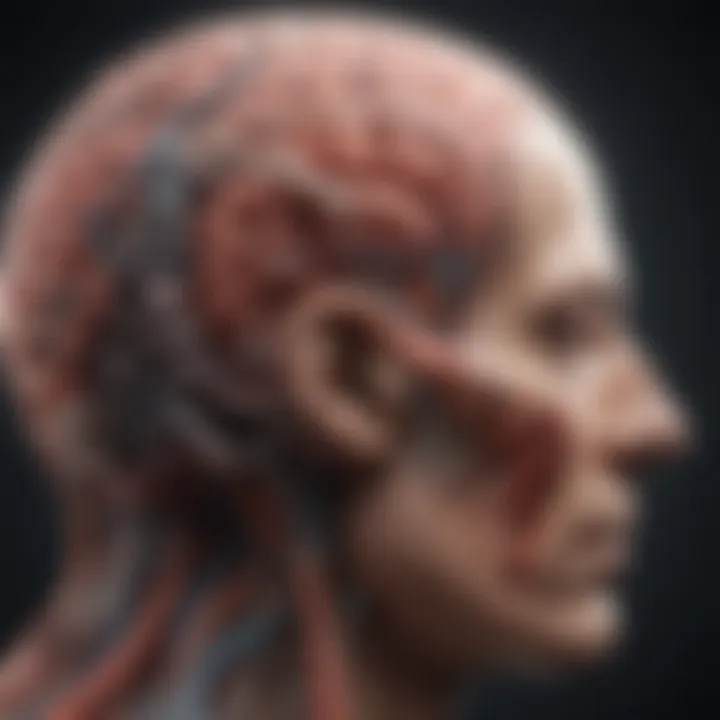Understanding the Pathophysiology of Major Depressive Disorder


Intro
Major Depressive Disorder (MDD) is a complex condition that affects millions globally. Understanding its pathophysiology is crucial for developing effective treatments and interventions. This article explores the various factors that contribute to MDD, including genetic, neurobiological, and environmental aspects. We will delve into the neuroanatomy involved in mood regulation, the role of neurotransmitters, and the impact of neuroinflammation and endocrine mechanisms. By synthesizing recent research, we aim to provide clarity on the intricate mechanisms underpinning this disorder and highlight potential therapeutic avenues.
Research Overview
Methodological Approaches
Research on the pathophysiology of MDD utilizes various methodological approaches. One common method is neuroimaging, which allows researchers to study brain structures and functions in individuals with MDD. Techniques such as functional MRI (fMRI) and positron emission tomography (PET) are instrumental in identifying abnormalities in brain areas linked to mood regulation. Genetic studies also play a significant role, examining polymorphisms in neurotransmitter systems that may predispose individuals to depression. Moreover, longitudinal studies help in understanding how environmental factors interact with genetic predisposition in the development of MDD.
Significance and Implications
Understanding the pathophysiology of MDD is of utmost importance. With a clearer grasp of how genetic, neurobiological, and environmental factors converge, researchers can identify new therapeutic targets. Insights into neurotransmitter dysfunction may lead to the development of more effective pharmacological treatments. Furthermore, knowledge of neuroinflammation may open avenues for novel anti-inflammatory strategies in managing MDD. Overall, the implications of this research extend beyond treatment, influencing public health strategies and health policies.
Current Trends in Science
Innovative Techniques and Tools
Recent advancements are reshaping the research landscape for MDD. Machine learning algorithms are increasingly applied to analyze large datasets, revealing complex patterns that may not be visible through traditional analyses. Additionally, advancements in genetic sequencing technology enhance our understanding of the genetic underpinnings of MDD, allowing for a more detailed exploration of its biology.
Interdisciplinary Connections
MDD research increasingly connects with various fields, such as psychology, neuroscience, and epidemiology. Such interdisciplinary collaboration fosters a holistic understanding of the disorder. For instance, insights from psychology on cognitive patterns can inform neurobiological studies, while epidemiological data can guide public health initiatives targeting depression prevention. By integrating knowledge across disciplines, researchers can develop comprehensive models of MDD that better explain its complexities.
"Understanding the pathophysiology of MDD enriches not only the treatment landscape but also enhances our overall comprehension of mental health as a whole."
Through these sections, we will continue to explore the various dimensions of MDD, providing a framework for understanding its underlying mechanisms and progression.
Foreword to Major Depressive Disorder
Major depressive disorder (MDD) is a complex and multifaceted mental health condition that significantly impacts individuals and society as a whole. Understanding this disorder is crucial, not only for academics but also for practitioners in mental health fields. Recognizing the various dimensions of MDD can lead to improved diagnosis, treatment, and overall outcomes for affected individuals.
Definition and Diagnostic Criteria
MDD is characterized by persistent sadness and a lack of interest or pleasure in previously enjoyable activities. According to the Diagnostic and Statistical Manual of Mental Disorders, Fifth Edition (DSM-5), the diagnosis of MDD requires the presence of at least five symptoms during the same two-week period. Some common symptoms include:
- Depressed mood most of the day
- Significant weight loss or gain
- Insomnia or hypersomnia
- Fatigue or loss of energy
- Feelings of worthlessness or excessive guilt
These symptoms should not be attributable to another medical condition or substance use. Meeting these criteria is essential for clinicians to accurately identify and manage the disorder.
Prevalence and Impact
MDD is one of the most common mental health disorders worldwide. Approximately 264 million people are affected globally, according to the World Health Organization. This widespread prevalence underscores the urgency of understanding the disorder.
The impact of MDD is profound. It not only disrupts individuals' lives but also affects families, workplaces, and communities. The disorder can lead to:
- Decreased productivity
- Increased healthcare costs
- Higher rates of suicide Hence, addressing MDD is not just a clinical necessity; it is a substantial public health concern.
"An estimated 800,000 people die by suicide every year, and depression is a significant risk factor."
In summary, comprehending the introduction to MDD lays the groundwork for exploring its pathophysiology. Identifying the characteristics, prevalence, and implications of this disorder is vital for enhancing our overall understanding and informing ongoing research and intervention strategies.
Genetic Factors in Major Depressive Disorder
The study of genetic factors in major depressive disorder (MDD) plays a crucial role in understanding the disorder's complex nature. This section evaluates how genetic predisposition interplays with environmental influences to shape individual susceptibility to MDD. Recognizing the genetic contributors can lead to better prevention, diagnosis, and treatment methodologies. This knowledge underscores the significance of conducting research in this domain, emphasizing genetics as a pillar in our understanding of MDD.
Heritability Estimates
Research suggests that major depressive disorder has a heritability estimate of approximately 37% to 50%. This statistic indicates that a considerable portion of the risk for developing MDD can be attributed to genetic factors. However, heritability does not imply direct genetic causation. It simply signifies a genetic vulnerability that, when combined with environmental stressors, may trigger the onset of depressive episodes. Genes involved might regulate neurotransmitter systems and neuroplasticity, thus influencing an individual's mood and behavior.
Several twin studies are particularly significant to heritability assessments. These studies reveal that monozygotic twins are more likely to both experience MDD compared to dizygotic twins. This finding provides strong evidence of genetic involvement in the disorder. Furthermore, large-scale genome-wide association studies have identified specific genetic loci linked to MDD. These discoveries are vital as they can guide researchers in pinpointing additional factors.
Gene-Environment Interactions
The interaction between genetic predisposition and environmental factors is critical in understanding MDD. This gene-environment interplay suggests that while individuals may inherit genes associated with depression, the expression of these genes can be influenced by their experiences. Stressful life events, such as trauma, loss, or chronic illness, can exacerbate genetic vulnerabilities, effectively tipping the balance towards the development of MDD.
The diathesis-stress model illustrates this concept well. According to this model, individuals with a genetic predisposition to MDD are more susceptible to developing the disorder when exposed to stressors. Specific genes, like those involved in the serotonin transport pathway, have been shown to interact with environmental factors, influencing emotional responses and coping mechanisms.
In summary, understanding genetic factors, including heritability and gene-environment interactions, is essential for unraveling the complexities of major depressive disorder. This knowledge not only enhances our understanding of MDD but also aids in developing targeted interventions that can mitigate risk and improve treatment outcomes.
Neuroanatomical Structures and Their Role
Understanding the neuroanatomical structures involved in Major Depressive Disorder (MDD) is crucial. These structures are essential for mood regulation and emotional processing. Individual differences in their function and connectivity can influence susceptibility to depression. Dysfunction in these areas can lead to significant consequences for emotional health and behavior. Research suggests that abnormalities in brain structure and activity have a direct correlation with depressive symptoms.
The Role of the Prefrontal Cortex
The prefrontal cortex (PFC) is a significant region associated with higher cognitive functions, including decision-making, social behavior, and emotional regulation. In the context of MDD, structural and functional impairments in the PFC have been well documented. These deficits often correspond with the common symptoms of depression, such as difficulty in concentrating and emotional dysregulation.
Functional imaging studies have shown reduced activity in the PFC of depressed individuals. Furthermore, this region interacts closely with other brain areas responsible for emotional processing. An impaired PFC may lead to increased rumination and the amplification of negative thoughts, contributing to depressive episodes. Thus, the PFC is integral not only in mood regulation but also in the overall cognitive and emotional landscape of individuals suffering from MDD.


The Limbic System and Emotion Regulation
The limbic system plays a pivotal role in emotion regulation and is essential when discussing the pathophysiology of MDD. This complex network includes structures like the amygdala and hippocampus, which are directly involved in emotional response and memory formation. In individuals with depression, the amygdala often shows heightened activity, correlating with increased feelings of fear and anxiety. On the other hand, the hippocampus, which is critical for memory and emotional balance, may exhibit reduced volume in those with MDD.
This dysfunction can lead to impaired emotional processing and negative biases in thinking. The balance between these limbic structures is essential for maintaining mood stability. When disrupted, it can contribute to a vicious cycle of negative emotions and cognitive distortions, further entrenching depressive symptoms.
Understanding these neuroanatomical structures gives insight into the complexities of MDD. The interplay between the PFC and the limbic system is crucial for developing new therapeutic approaches aimed at restoring balance and improving emotional health in those affected by this disorder.
Neurotransmitter Systems in
Serotonin Dysfunction
Serotonin is a key neurotransmitter affected in MDD. It is primarily known for its role in mood regulation and emotional balance. Dysregulation of serotonin levels can lead to various symptoms associated with depression, such as persistent sadness, anxiety, and changes in appetite or sleep patterns. Research indicates that individuals with MDD often have lower serotonin levels or impaired serotonin transmission. This dysfunction is the target of several antidepressant medications, commonly referred to as selective serotonin reuptake inhibitors (SSRIs). These drugs aim to increase serotonin availability in the synaptic cleft, thus improving mood and emotional stability. However, the exact mechanisms by which serotonin impacts depression remain complex and multifaceted, often affected by other factors such as genetics and environmental influences.
Norepinephrine and Dopamine Imbalances
Apart from serotonin, norepinephrine and dopamine are also critical neurotransmitters involved in MDD. Norepinephrine plays an important role in arousal, alertness, and mood regulation. An imbalance in norepinephrine transmission may contribute to lethargy and decreased motivation, common features of depression.
Dopamine, associated with the brain's reward and pleasure centers, is another neurotransmitter that exhibits dysfunction in MDD. Low levels of dopamine can lead to anhedonia, or the inability to experience pleasure, impacting an individual’s interests and engagement in life. Both norepinephrine and dopamine systems can be targeted in treatment; medications such as serotonin-norepinephrine reuptake inhibitors (SNRIs) aim to address these imbalances effectively.
The interplay between serotonin, norepinephrine, and dopamine highlights the complexity of MDD. Effective treatment often requires an understanding of how these neurotransmitters interact and influence one another.
Understanding neurotransmitter systems in MDD is vital for therapeutic strategies. Future research into these biochemical pathways will aid in developing more targeted and effective treatments for individuals suffering from major depressive disorder.
Neuroinflammation and
Moreover, neuroinflammation may interact with other factors, such as genetic predispositions and stress, compounding the risk for developing MDD. The recognition of neuroinflammation as a contributing factor opens new avenues for investigating treatments that could target these inflammatory processes.
Cytokine Production
Cytokines are small proteins produced by various cells in response to inflammation. They play a pivotal role in cell signaling. In the context of MDD, several studies indicate that pro-inflammatory cytokines, such as interleukin-6 and tumor necrosis factor-alpha, are often elevated in individuals suffering from depression.
Research shows that elevated levels of these cytokines in blood and cerebrospinal fluid correlate with increased depressive symptoms.
Chronic inflammation may disrupt neurotransmitter metabolism, leading to reduced serotonin and dopamine levels. This dysfunction contributes significantly to the mood dysregulation characteristic of MDD. The potential for cytokines to affect neuroplasticity and neuronal survival further emphasizes their relevance in understanding the biological basis of depression.
Microglial Activation
Microglia are the resident immune cells in the brain, and their activation is a key feature of neuroinflammation. Upon activation, microglia can release cytokines, reactive oxygen species, and other neurotoxic factors. While microglial activation serves a protective role during initial immune responses, chronic activation may lead to detrimental effects.
Studies have shown that excessive microglial activation can exacerbate depressive symptoms. It is also found that individuals with MDD exhibit a higher density of activated microglia in specific brain regions such as the prefrontal cortex and hippocampus. These findings suggest that controlling microglial activation may be beneficial in developing new therapeutic strategies for MDD.
In summary, both cytokine production and microglial activation are central components of the neuroinflammatory response seen in MDD. Addressing these mechanisms could lead to innovative approaches in treatment and prevention.
Endocrine Factors in Major Depressive Disorder
Hypothalamic-Pituitary-Adrenal (HPA) Axis Dysfunction
The hypothalamic-pituitary-adrenal axis is central to the body’s stress response. Dysregulation of the HPA axis is often observed in individuals with MDD. In a typical response to stress, the hypothalamus releases corticotropin-releasing hormone, prompting the pituitary gland to secrete adrenocorticotropic hormone, which in turn stimulates the adrenal glands to produce cortisol.
In cases of MDD, there is usually an increase in cortisol levels. Elevated cortisol can lead to various negative outcomes, including impaired neurogenesis, especially in the hippocampus. This structure is vital for mood regulation and cognitive functions. High cortisol levels may also lead to alterations in serotonin and norepinephrine systems, exacerbating depressive symptoms.
The alteration in HPA axis functioning underlines the importance of stress management strategies in the treatment of MDD. Some interventions target these hormonal imbalances, highlighting the significance of the endocrine system in understanding and treating depression.
Thyroid Hormones and Mood Regulation
Thyroid hormones, particularly thyroxine (T4) and triiodothyronine (T3), are essential for maintaining metabolic functions and overall energy levels. There is a notable connection between thyroid function and mood disorders. Hypothyroidism often coexists with MDD, and symptoms of low thyroid hormone levels can mimic those of depression, such as fatigue, weight gain, and cognitive sluggishness.
Research shows that individuals with MDD may have altered levels of thyroid hormones. Testing thyroid function can be important in evaluating and treating depressive symptoms. In many cases, restoring normal thyroid levels through hormone replacement therapy has resulted in mood improvement.
Furthermore, certain studies suggest that the effectiveness of treatments for MDD may be influenced by thyroid hormone status. Therefore, a comprehensive evaluation that includes thyroid function testing can contribute significantly towards a better understanding of mood disorders and refining treatment approaches.
"Thyroid hormone status should always be considered in the evaluation of mood disorders."
The endocrine system serves as a critical component in understanding MDD. Both the HPA axis and thyroid hormones illustrate how hormonal issues can intertwine with depressive states, emphasizing the need for a holistic approach in both research and clinical practice. By acknowledging these endocrine factors, we can tailor interventions more effectively for those affected by major depressive disorder.
Cognitive and Behavioral Aspects
Cognitive and behavioral aspects are central to understanding Major Depressive Disorder (MDD). They are not only significant in the development of the disorder but also have implications for treatment. Cognitive processes involve the way individuals perceive and interpret their experiences, while behavior relates to how these thoughts influence actions.
Negative thought patterns are prevalent among individuals suffering from MDD. These patterns contribute to feelings of hopelessness and helplessness. Cognitive distortions, such as all-or-nothing thinking and overgeneralization, can reinforce the depressive state. Such negative cognitions lead to a skewed perception of situations, which can exacerbate symptoms of MDD.
Negative Thought Patterns
Negative thought patterns are a hallmark of MDD. These thought processes often manifest as persistent rumination. Individuals may dwell on past failures or perceived inadequacies, creating a cycle of negativity. This rumination can hinder one's ability to engage in positive activities or relationships, isolating the individual further.
A key theory in cognitive psychology is Aaron Beck's cognitive triad, which posits that individuals with depression have a negative view of themselves, their experiences, and their future.
The following are some common cognitive distortions found in MDD:
- All-or-Nothing Thinking: Seeing situations in black-and-white terms, without recognizing the gray areas.
- Overgeneralization: Taking one negative experience and assuming it applies broadly to all situations.
- Catastrophizing: Expecting the worst possible outcome in every situation.


Therapeutic approaches, such as Cognitive Behavioral Therapy (CBT), specifically target these patterns. CBT aims to challenge and reframe these negative cognitions, encouraging patients to develop healthier thought processes.
Stress and Coping Mechanisms
Stressful events and poor coping mechanisms significantly contribute to the onset and persistence of MDD. Individuals may face high levels of stress due to various environmental factors, such as work pressure, family conflicts, or financial difficulties. How one copes with these stressors can determine whether they will be pushed into a depressive episode.
Effective coping mechanisms are essential for mental health. Some people use adaptive strategies like problem-solving or seeking support, while others may resort to avoidance or denial.
Research shows that maladaptive coping strategies can increase vulnerability to depressive symptoms. These may include:
- Avoidance: Ignoring problems or responsibilities, leading to increased stress.
- Substance Abuse: Using drugs or alcohol to escape feelings of distress.
- Aggression: Redirecting feelings of anger inward or outward, creating a toxic cycle.
Promoting positive coping strategies, such as engaging in physical activity or mindfulness practices, can be beneficial. Support systems, whether from family or friends, also play a critical role in providing emotional sustenance during challenging times.
"Understanding the interplay between cognitive patterns, stress, and coping mechanisms is vital for identifying therapeutic interventions that can alleviate the burden of Major Depressive Disorder."
In summary, cognitive and behavioral aspects encompass significant factors in the pathophysiology of MDD. By addressing negative thought patterns and enhancing coping strategies, it is possible to improve treatment outcomes and foster better mental health for affected individuals.
Environmental Factors Contributing to
Environmental factors play a significant role in the development and persistence of Major Depressive Disorder (MDD). These factors can interact with genetic predispositions, underscoring the complexity of the disorder. Understanding these contributions helps illuminate pathways for potential intervention and prevention strategies. Both early life experiences and socioeconomic conditions can dramatically shape mental health outcomes, making this area of study critical in the context of MDD.
Early Life Stress and Trauma
Early life stress and trauma are among the most impactful environmental factors influencing MDD. Research indicates that adverse childhood experiences, such as abuse, neglect, or family dysfunction, increase the likelihood of developing depression later in life. Early exposure to stress can lead to maladaptive changes in brain structure and function. The hypothalamic-pituitary-adrenal (HPA) axis, which regulates stress responses, often exhibits dysregulation due to such experiences. This alteration can result in heightened anxiety and emotional instability, potentially triggering depressive episodes.
Factors such as parental separation, loss of a caregiver, or exposure to domestic violence can result in psychological scars that manifest as depressive symptoms in adulthood. The chronic activation of stress pathways can also lead to alterations in neurotransmitter systems, affecting mood regulation. The connection between early trauma and MDD highlights the need for early detection and intervention, addressing these adverse conditions before they result in more severe mental health challenges.
Socioeconomic Influences
Socioeconomic status (SES) is another vital environmental factor contributing to MDD. Individuals from lower socioeconomic backgrounds often face increased levels of stressors, such as financial instability, unemployment, and inadequate access to healthcare. These stressors can compound existing vulnerabilities, leading to a higher incidence of depression. There is a clear link between poverty and mental health; the uncertainty and hardship associated with low income can create a chronic stress state.
Moreover, individuals with lower SES may have less access to supportive resources like mental health care and social networks, which can further exacerbate feelings of isolation and hopelessness. In turn, these feelings can deepen depression, creating a cycle that is difficult to escape.
According to some studies, individuals facing economic hardships are less likely to seek help for their mental health issues. This reluctance is often due to stigma or a lack of understanding about available resources. Aside from financial factors, community environments, such as living in high-crime areas or lacking community ties, can also contribute to higher rates of depression.
"Understanding the interplay of environmental factors and MDD can foster a more holistic view of treatment strategies, addressing social determinants of health as crucial adjuncts to psychological interventions."
In summary, both early life stress and socioeconomic influences are critical environmental factors in understanding the complexities of MDD. Recognizing their roles can lead to more comprehensive approaches in mental health care, assisting individuals in overcoming their challenges.
The Role of Psychosocial Factors
Psychosocial factors encompass a range of influences that affect an individual's mental health and emotional well-being. In the context of Major Depressive Disorder (MDD), understanding these factors is crucial. They interconnect with biological and environmental aspects, shaping the onset, progression, and outcome of the disorder. Research shows that the psychosocial environment plays a determinative role in how individuals respond to stressors, impacting their overall mental health.
Exploring psychosocial factors sheds light on why some individuals develop MDD while others, despite facing similar stressors, do not. Recognizing these aspects helps in creating tailored interventions that address both psychological and social dimensions of depression.
Social Relationships and Support Systems
Social connections and support systems are fundamental in influencing one's mental health. Positive relationships can provide emotional support, practical assistance, and a sense of belonging, all of which are vital in buffering against depressive symptoms. Conversely, social isolation and negative interactions can exacerbate feelings of hopelessness and sadness.
Key considerations about social relationships include:
- The quality of relationships often outweighs quantity; meaningful conversations and emotional bonds are essential.
- Support systems can offer effective coping strategies, making it easier to navigate life's challenges.
- Peer support groups and community connections can facilitate shared experiences, reducing stigma around MDD.
- Family dynamics often play a critical role in either supporting or hindering recovery.
Research indicates that strong support networks can significantly reduce the risk of developing depression and can enhance recovery for those already affected.
Cultural Influences on Depression
Cultural context significantly shapes perceptions of mental health and illness, including MDD. Different cultures have varying beliefs about the nature of depression, its causes, and appropriate responses. These cultural frameworks can influence how individuals express symptoms and seek help.
Important elements related to cultural influences include:
- Stigma associated with mental health may differ; in some cultures, discussing depression is taboo, which hinders individuals from seeking treatment.
- Cultural narratives and values can dictate emotional expression, impacting how individuals cope with depressive symptoms.
- Access to treatment options may be limited by socio-cultural factors, affecting the support available to those with MDD.
Understanding these cultural influences is vital in developing effective interventions that respect and incorporate individual backgrounds and beliefs. This acknowledgment can pave the way for more inclusive mental health practices, making it easier for affected individuals to engage with treatment.
Current Research Directions
Research into Major Depressive Disorder (MDD) continues to evolve, bringing forth new understanding and potential avenues for treatment. The investigation of MDD includes the integration of advanced techniques and innovative methodologies that shed light on the complex mechanisms underlying this disorder. Current research directions are pivotal in not only delineating the pathophysiological aspects of MDD but also in streamlining various therapeutic strategies.
Innovative Biomarkers
Innovative biomarkers are becoming increasingly important in the reliable diagnosis and treatment of MDD. Traditional diagnostic methods primarily rely on clinical interviews and subjective assessments, which can be limited in accuracy. Biomarkers, on the other hand, provide objective indications of biological processes associated with MDD.
Some promising biomarkers under investigation include specific cytokines, neurotrophic factors, and neuroimaging signals. These biological markers can help in predicting treatment response, understanding disease progression, and evaluating relapse risk.
Research in this area offers the possibility of developing personalized treatment plans which could lead to better outcomes for patients. The identification of a unique panel of biomarkers may facilitate a more targeted approach, optimizing pharmacological and psychotherapeutic interventions.
Neuroimaging Advances
Neuroimaging has transformed the understanding of the brain's structure and function in relation to MDD. Techniques such as functional magnetic resonance imaging (fMRI) and positron emission tomography (PET) allow researchers to visualize brain activity and assess neuroanatomical changes associated with depression.
Recent advances in neuroimaging technology have improved the sensitivity and specificity of brain assessments. These improvements help in identifying the dysfunctions in neural circuitry, especially those involving the prefrontal cortex and limbic system, which are implicated in mood regulation.
Moreover, neuroimaging studies can illuminate how treatment modalities—such as medications or psychotherapy—alter brain activity over time. Understanding these alterations can guide future therapeutic strategies and enhance the efficacy of existing ones.


"The integration of innovative biomarkers and neuroimaging advancements represents a significant leap forward in the pursuit of better understanding and treating Major Depressive Disorder."
As research progresses in these areas, it fosters a deeper comprehension of the multifaceted nature of MDD and cultivates the environment for advancing therapeutic approaches tailored to individual patients.
Therapeutic Implications
The topic of therapeutic implications is central in understanding the management of major depressive disorder (MDD). Effective treatment strategies aim to alleviate symptoms and improve the overall quality of life for individuals suffering from this condition. This section reviews the various therapeutic approaches, focusing particularly on pharmacological treatments and psychotherapy. Each of these approaches has its own set of benefits and considerations that can play a significant role in individual treatment plans.
Pharmacological Treatments
Pharmacological treatments for MDD primarily involve the use of antidepressants. There are several classes of these medications, each working via different mechanisms. Common types include selective serotonin reuptake inhibitors (SSRIs), serotonin-norepinephrine reuptake inhibitors (SNRIs), and atypical antidepressants.
- SSRIs such as fluoxetine and sertraline are often the first line of treatment due to their favorable side effect profile.
- SNRIs, like venlafaxine, can be effective for patients who do not respond to SSRIs.
- Atypical antidepressants offer alternatives for individuals with specific symptoms or side effects from traditional antidepressants.
While these medications can be effective, their use is not without challenges. Side effects may occur, including weight gain, sexual dysfunction, or gastrointestinal disturbances. It often takes weeks for patients to notice the full effects of these medications. Regular monitoring by healthcare providers is essential to find the right medication and dosage.
Psychotherapy and Behavioral Interventions
Psychotherapy is another pivotal component in the treatment of MDD. Cognitive-behavioral therapy (CBT) is one of the most researched and widely used forms. It focuses on changing negative thought patterns and behaviors associated with depression. Through CBT, patients learn coping strategies that help manage their symptoms.
- Other therapeutic modalities include interpersonal therapy (IPT) and dialectical behavior therapy (DBT).
- Group therapy can also be beneficial, providing social support and shared experiences among individuals facing similar struggles.
Behavioral interventions often complement pharmacological treatments. Combining both approaches can enhance the overall therapeutic effect. It is important to tailor interventions to each individual's needs, as MDD manifests uniquely in different patients. A collaborative approach between patients and clinicians is crucial to ensure optimal outcomes.
Overall, a comprehensive understanding of therapeutic implications in MDD emphasizes the necessity for individualized treatment plans that prioritize both medication and psychotherapy to facilitate recovery.
Challenges in Understanding
Understanding Major Depressive Disorder (MDD) presents significant scientific and clinical challenges. These challenges arise from the intricate and multifaceted nature of depression itself. It is essential to recognize that MDD does not have a single cause; instead, it results from a combination of genetic, biological, psychological, and environmental factors. A deeper exploration of these elements facilitates a better appreciation of the hurdles faced in diagnosing and treating MDD effectively.
Biological Versus Psychological Perspectives
The debate between biological and psychological perspectives is a central theme in the study of MDD. Biologically, depression is often associated with neurotransmitter imbalances, particularly involving serotonin, norepinephrine, and dopamine. Imaging studies have linked MDD with structural and functional changes in key brain areas. On the other hand, psychological perspectives emphasize cognitive distortions, negative thought patterns, and behavioral responses to stressors.
Research has shown that both perspectives are important to understanding MDD. For instance, genetic predispositions can make an individual more vulnerable to psychological stress, while chronic psychological distress may trigger or exacerbate biological processes.
"Understanding the interaction between both perspectives is crucial for developing effective interventions that address the full spectrum of the disorder."
Stigma and Misconceptions
Stigma related to MDD remains a considerable barrier to effective treatment and understanding. Many people still perceive depression as a weakness or a personal failing rather than a legitimate medical condition. This misconception can prevent individuals from seeking help or adhering to treatment.
The stigma can also extend to the healthcare professionals themselves, who may hold biased views towards patients with MDD. Misunderstanding the disorder can lead to dismissive attitudes, impacting the quality of care and support that patients receive.
Moreover, misinformation about depression can create unrealistic expectations regarding treatment outcomes. For example, many believe that antidepressants immediately alleviate depressive symptoms, neglecting that therapeutic processes often take time and may vary between individuals.
To move forward, effort must be directed toward education and awareness to dismantle these stigmas and misconceptions. Accurate public information plays a vital role in fostering empathy and understanding in society.
Future Directions in Research
The exploration of future directions in Major Depressive Disorder (MDD) research is crucial for advancing our understanding of this complex condition. As we identify the factors that contribute to MDD, the need for innovative and integrated research approaches becomes increasingly significant. This section discusses the integral aspects of such research avenues, emphasizing their potential benefits and considerations.
Integrative Approaches
Integrative approaches in MDD research focus on combining insights from various disciplines, including genetics, neurobiology, psychology, and sociology. Such multidisciplinary perspectives can enhance our understanding of the disorder. Incorporating diverse methodologies promotes the holistic study of MDD.
- Biopsychosocial Model: This model acknowledges the interaction of biological, psychological, and social factors. It highlights how these components influence an individual's vulnerability to MDD. Research guided by this framework can uncover novel intervention strategies.
- Collaborative Studies: Interdisciplinary initiatives involving psychiatrists, neuroscientists, geneticists, and therapists are essential. Such collaborative efforts can foster comprehensive research that incorporates diverse viewpoints and expertise.
"Integrative research has the potential to yield breakthroughs that could change how we approach treatment and management of MDD."
Precision Medicine in Treatment
Precision medicine represents a promising frontier in treating MDD, tailoring interventions based on individual patient characteristics. This approach aims to move away from one-size-fits-all treatments to personalized care.
- Genomic Insights: Understanding genetic variants linked to MDD can guide the selection of treatments. For instance, pharmacogenomics studies the impact of genetics on drug response. By recognizing specific genetic markers, clinicians can better predict which antidepressants may be effective for individual patients.
- Biomarker Development: Identifying biomarkers associated with MDD could facilitate more accurate diagnoses and treatment plans. Neuroimaging and other diagnostic tools can help map the brain's activity patterns, guiding targeted interventions.
- Tailored Psychosocial Interventions: Recognizing that psychosocial factors also contribute to MDD, precision medicine advocates for treatments that consider a patient’s personal history, environment, and socio-economic status. This personalized approach can optimize therapeutic outcomes.
In summary, future directions in MDD research underline the importance of integrative strategies and precision medicine. By broadening our investigative scope, we can develop more effective interventions and offer hope to those affected by this disorder.
Closure
The conclusion in this article is vital for summarizing the intricate relationships between the various factors contributing to major depressive disorder (MDD). It synthesizes the findings from different sections, highlighting how genetic, neurobiological, and environmental elements all play a part in the disorder's development and persistence. By consolidating these insights, reader will gain a clearer perspective on the multifaceted nature of MDD.
Summary of Key Findings
Major depressive disorder is influenced by numerous interconnected components. Key findings include:
- Genetic Influences: Studies indicate a significant heritability rate, underscoring the importance of genetic predispositions in MDD. Specific gene-environment interactions further elucidate the complexities of this disorder.
- Neuroanatomy: Brain structures such as the prefrontal cortex and limbic system are crucial in mood regulation. Dysfunction in these areas often coincides with depressive symptoms.
- Neurotransmitter Imbalance: The roles of serotonin, norepinephrine, and dopamine highlight the biochemical disruptions that underlie depressive states.
- Neuroinflammation: Elevated cytokine levels and microglial activation suggest a link between inflammation and MDD, pointing toward potential therapeutic avenues.
- Endocrine Factors: Dysregulation of the HPA axis and thyroid hormones illustrates the biological processes that can exacerbate mood disorders.
These points emphasize the importance of a comprehensive understanding of MDD, as they interconnect to create a roadmap for both diagnosis and treatment.
Implications for Future Research and Treatment
The findings from this article point to several critical areas for future research and implications for treatment:
- Innovative Biomarkers: Identifying and validating biomarkers linked to MDD could enhance diagnostic accuracy and tailor treatments to individual patients.
- Personalized Treatments: Precision medicine approaches may provide more effective therapies by taking into consideration an individual's genetic makeup and environmental factors.
- Interdisciplinary Studies: Collaborative efforts among geneticists, neuroscientists, and psychologists can lead to deeper insights into MDD’s pathophysiology.
- Cultural and Environmental Context: Future studies should not overlook socio-cultural elements that might influence the presentation and perception of MDD.



